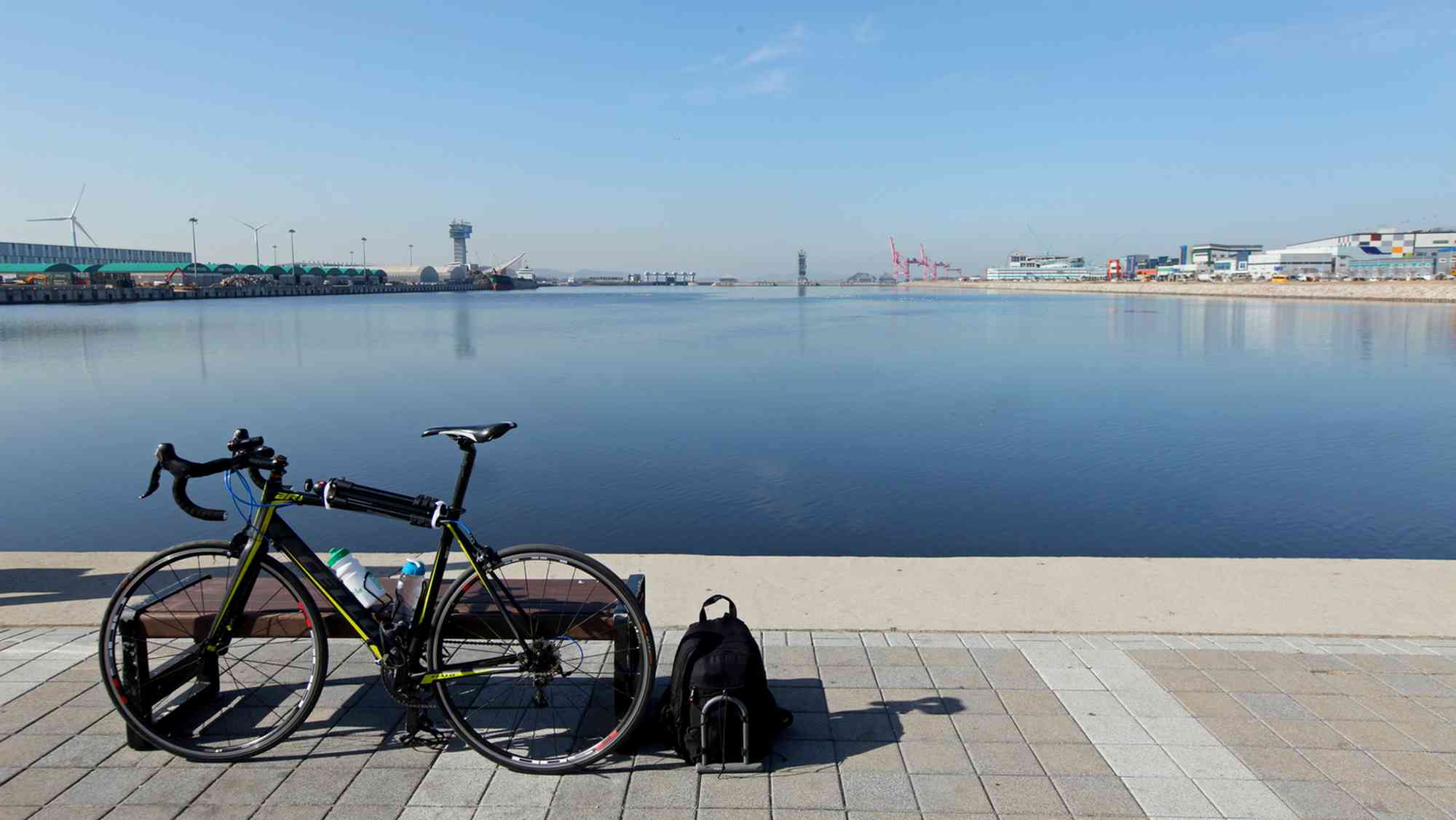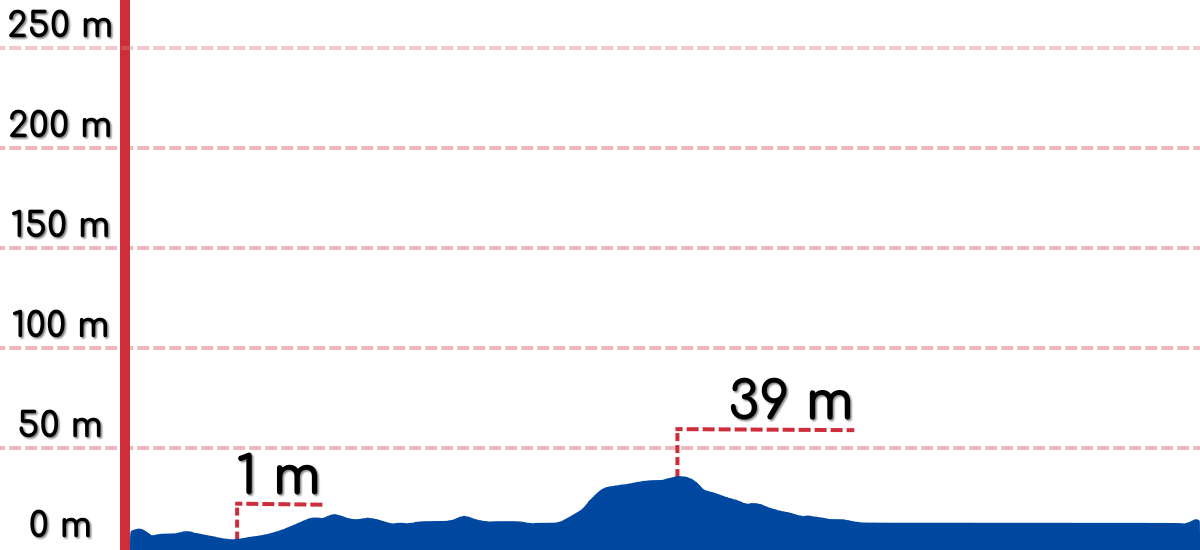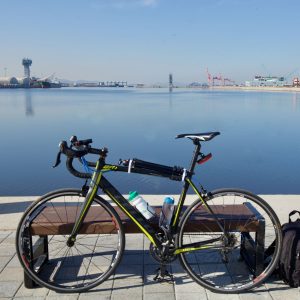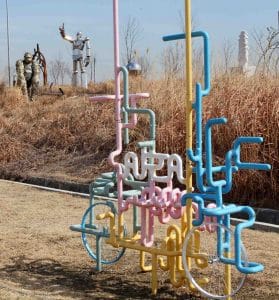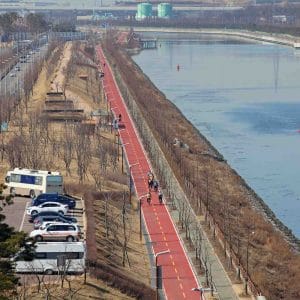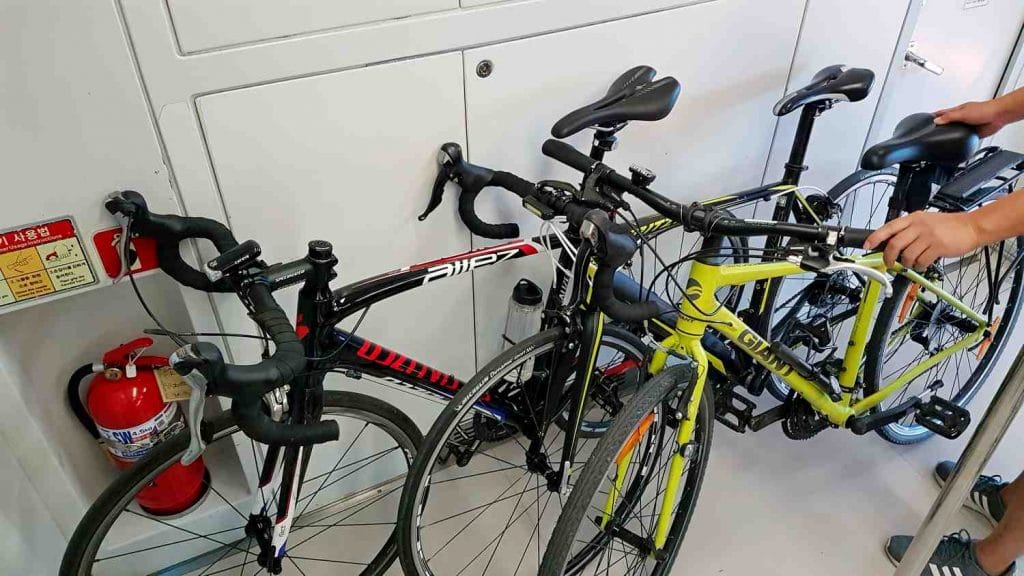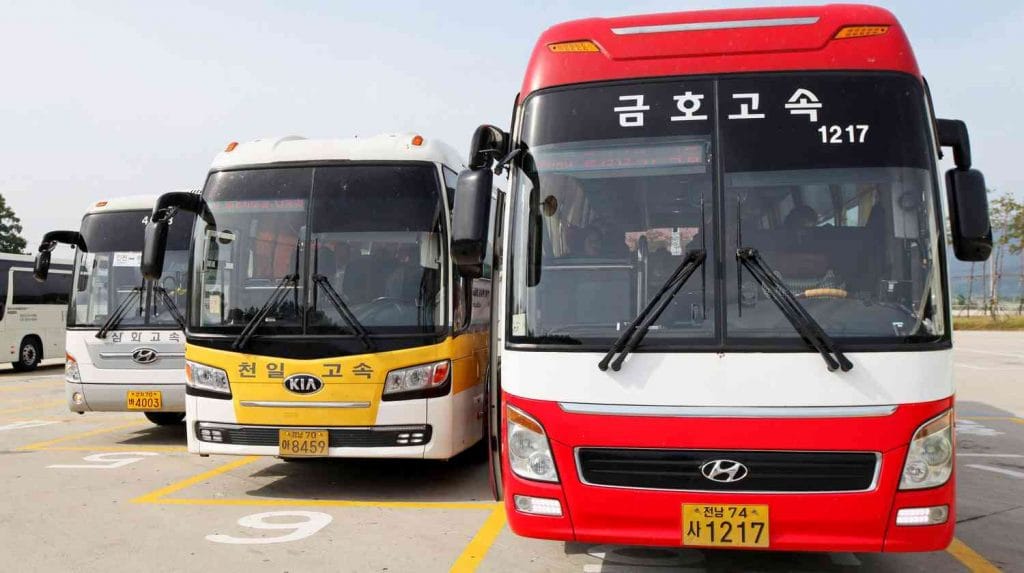Ara
Bicycle Path
Pack your gear! Limber up! Prepare yourself for… a leisurely cycle down a flat canal.
The Ara Bicycle Path (아라자 전거길; map) begins (or ends) the Cross-Country Route. It’s the shortest and flattest of all Korea’s certification bike paths.
The cycling course starts on Korea’s west coast near the Yellow Sea. It travels east through Incheon City, then spills onto the Han River in Seoul.
Incheon City
(인천시)
1 hour
Seoul City
(서울시)

- Time 1 hour (1/2 day)
- Length 21 km (13 miles)
- Elevation 39 m | 1 m (128 ft | 3 ft)
- Difficulty 🚲
- Certifications Cross-Country, Grand Slam
Bike from Incheon City to Seoul City. Learn the course and discover pathside landmarks.
Learn the history of the Ara Canal, which connects the Han River to the Yellow Sea in Incheon City.
Read about the top highlights along the Ara Bicycle Path, from an artificial waterfall to a waterside park.
Learn how to get you and your bicycle to the Ara Bicycle Path by bus, train, or plane.
Bike Path Overview

The Ara Bicycle Path follows the Gyeongin Ara Waterway, a man-made canal that connects the Han River (한강; map) in Seoul to the Yellow Sea (황해; map), known to Koreans as the West Sea.
The route begins near the Ara West Sea Lock, the point where the canal spills into the Yellow Sea. As you ride east towards Seoul, discover biking paths, parks, and other highlights on opposite sides of the canal.
The main bike path sails along the canal’s south side. But interesting landmarks inhabit the north side, as well.
Fourteen bridges connect the canal’s north and south banks. Under them sit bike rental stations, restrooms, art installations, and more park facilities.
The Ara Bike Path touches three cities.
- Incheon Metropolitan City (인천시; map) claims the majority of the bike path, from the Yellow Sea inwards.
- The west end of the bike path dips into Gimpo City (김포시; map) for a few hundred meters.
- The cycling routes ends inside the western border of Seoul (서울시; map).
Types of Paths & Difficulty
The Ara Bicycle Path is the easiest of Korea’s certification bike paths. It follows a flat canal for a meager 21 kilometers. Keep a steady pace and you can conquer its course in less than two hours.
North Side vs. South Side
Cycling paths run along both the north and south sides of the Ara Waterway. Both are flat and travel about 20 kilometers. But they have a few key differences.
Certification
The Ara Bicycle Path has two certification centers. One at the start line next to the Yellow Sea in Incheon. One at the finish line near the Han River in Seoul.
Collect both stamps to complete the Cross-Country and Grand Slam certifications. The Ara Bicycle Path does not have its own bike path certification.
Certification Centers
Here is a complete list of certification centers (red stamp booths) along the Ara Bike Path.
- Ara West Sea Lock (아라서해갑문 인증센터; map)
- Ara Hangang Lock (아라한강갑문 인증센터; map)
Highlights
Though the shortest certification bike path, the Ara Bicycle Path offers several scenic stops, curiosities, and architecture. Let’s go take a brief tour.
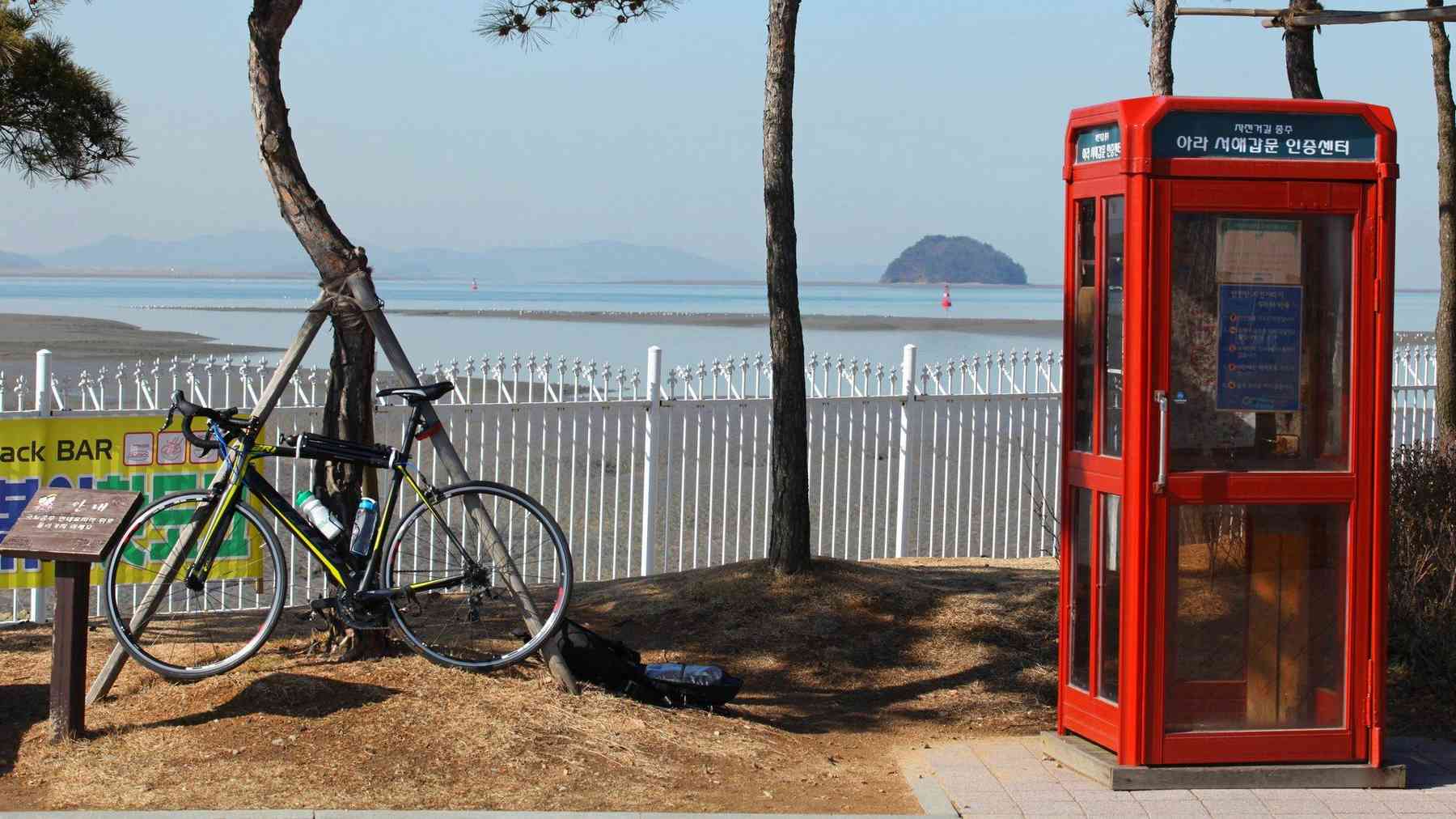
The Ara Bike Path begins on the edge of the Yellow Sea. Gaze westward. When the tide ebbs, you’ll see a vast muddy expanse surrounding Yeongjong Bridge and Yeongjong Island where Incheon International Airport hums.

The Gyeongin Ara Passenger Terminal are a pair of buildings that hang near the start of the Ara Bike Path, where the Ara Waterway spills into the Yellow Sea. A sweeping white beam resembling a ship’s sail connects the structures.

Sicheon Waterside Park sits a third of the way down the Ara Bike Path. The park straddles both sides of the Ara Waterway. Sicheon Bridge leaps over the canal and connects the park’s north and south areas.
Gyeongin Ara Waterway
The Ara Bicycle Path borrows its name from the Gyeongin Ara Waterway (경인 아라뱃길; map).
Let’s take that name apart.
- “Gyeong” (경) comes from an old name for Seoul.
- “In” (인) refers to the city of Incheon.
- “Ara” (아라) derives from Arirang, an ancient Korean folk song.
The Ara Waterway is Korea’s first human-made canal. Eighteen kilometers long. Eighty meters wide. Six meters deep. The canal starts at the Han River in Seoul and flows into the Yellow Sea.
How To Get There
Because the Ara Bike Path is located in Incheon, Korea’s third largest city, cyclists have three terrific options to get on and off the cycling course.
Subway
Are you in Seoul or Incheon? Need to get to the Ara West Sea Lock (map), the start of the Ara Bike Path and Cross-Country Route? While restricted, subways can help you get there.
The AREX (Airport Express) is an all-stop subway that takes passengers from Incheon International Airport to Seoul Station in downtown Seoul. However, passengers with full-size bikes may only ride on weekends by reserving in advance on the AREX website.
Can’t book a space on the AREX? There are alternatives.
Intercity Buses
Intercity buses are the best way to hop between cities with a bike. Here are three terminals that can help you get to the start of the Ara Bike Path.
- Incheon Bus Terminal sits in downtown Incheon. It is the closest and largest terminal near the Ara West Sea Lock.
- Bucheon Bus Terminal is located farther from the start of the bike path. But it offers an alternative entry point on weekdays, when subways don’t allow full-size bikes.
- Incheon International Airport runs buses from Korea’s largest airport all around Korea.
Airplanes
Coming from overseas? You’re in luck. Incheon International Airport lives on Yeongjong Island, which is visible from the start of the Ara Bike Path and Cross-Country Route.
So, can I cycle from the airport to the start line? No. The bridges connecting the island to the mainland only allow vehicles. No bikes.
However, subways and buses can escort you and your bike off the airport island.
Behind Seoul and Busan, Incheon Metropolitan City (인천광역시; map) is Korea’s third most populous city. It holds over three million residents.
Nestled against the Yellow Sea in the nation’s northwest, Incheon is a part of the Seoul Capital Area (수도권), which includes Gyeonggi Province (경기도; map) and its dozens of cities.
Incheon International Airport (인천국제공항; map) is the primary hub for Korea’s international travelers. In 2016, the airport ranked fifth for cargo and nineteenth for passengers worldwide.


